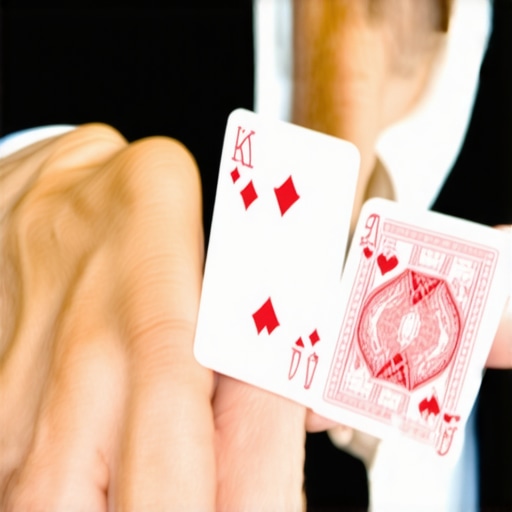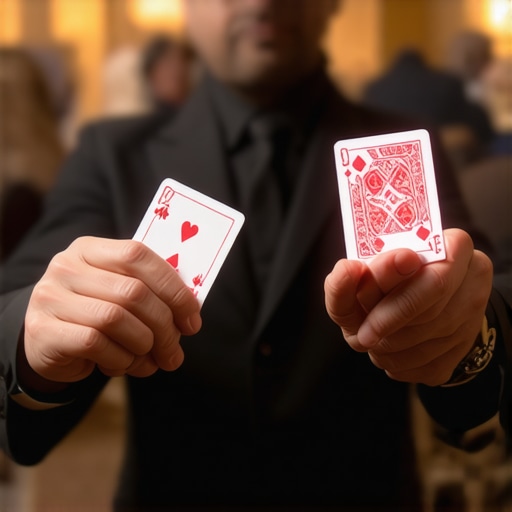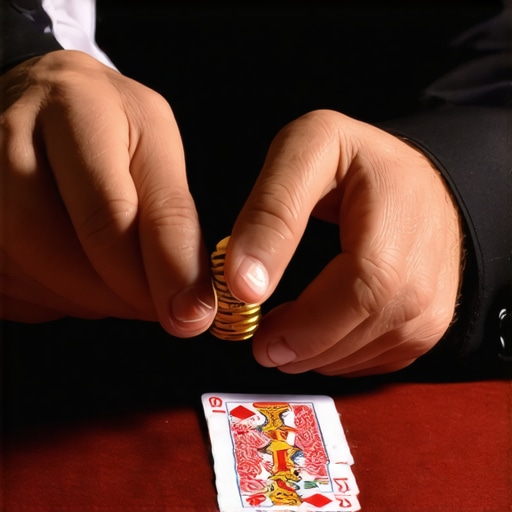My Personal Journey into the World of Sleight of Hand Magic at Trade Shows
As someone who has always been fascinated by the art of illusion, I vividly remember my first encounter with a professional magician during a bustling trade show. The way they effortlessly manipulated cards and coins left me in awe, sparking my curiosity about the secrets behind such seamless tricks. Over the years, I dedicated myself to mastering the art of sleight of hand, especially for energetic and interactive trade show environments where engaging an audience quickly is crucial.
Why Speed and Precision Are the Cornerstones of Effective Magic at Events
In my experience, the key to captivating trade show audiences is a combination of speed, precision, and confidence. Fast magicians excel because they can perform multiple illusions in a short span, keeping the crowd intrigued and eager to see more. I learned that practicing under real event conditions, not just in a mirror, significantly sharpened my sleight of hand skills. For those interested in elevating their trade show magic game, I highly recommend exploring comprehensive techniques like mastering sleight of hand for quick, trustworthy close-up magic.
How to Develop Your Own Rapid-Fire Magic Routine
Developing a routine that is both fast and mesmerizing requires a mix of technical skill and creative flair. I started by breaking down complex tricks into smaller, manageable sleights that I could execute quickly without hesitation. The secret is in repetitive practice until the moves become second nature, allowing you to perform smoothly even in high-pressure environments. Incorporating everyday objects like cards, coins, or even rubber bands can make your routine more relatable and spontaneous, enhancing audience engagement.
What Sets Fast Magicians Apart from Traditional Performers?
Fast magicians differentiate themselves through their ability to perform multiple illusions swiftly and seamlessly. This approach not only keeps the audience’s attention but also creates an energetic atmosphere that encourages participation. From my perspective, the real advantage lies in your capacity to read the crowd and adapt your pace accordingly, ensuring everyone feels involved and amazed. To deepen your understanding, I recommend exploring broader content on magic techniques and audience psychology.
Ever Wondered How to Master the Art of Rapid Magic?
Practicing consistently and seeking feedback from fellow magicians helped me refine my skills. Remember, the goal isn’t just speed but also maintaining the illusion of ease and naturalness. Connecting with experienced professionals or joining magic communities can provide invaluable insights and support. I found that watching expert performances and analyzing their techniques was particularly enlightening.
If you’re serious about taking your trade show magic to the next level, sharing your experiences or asking questions in the comments can be a great way to learn and grow. Also, don’t forget to explore additional resources to expand your magic repertoire and boost your confidence.
The Nuances of Timing and Audience Interaction in Rapid Magic
One often-overlooked aspect of high-speed magic is the importance of timing and audience engagement. When performing rapid illusions, your ability to read cues from the crowd and adjust your pace accordingly can make the difference between a fleeting trick and a memorable experience. For example, a slight pause after a particularly astonishing move can heighten anticipation, allowing the audience to fully absorb the illusion before moving on to the next. This rhythmical balance between speed and pause is a nuanced skill that elevates your entire act.
How Can Mastering the Psychology of Audience Perception Enhance Your Speed Magic?
Understanding audience psychology is vital. As an expert, I can tell you that perception plays a crucial role in how illusions are received. People tend to focus on what is most salient—the magician’s hands, the object, or the subtle misdirection. By mastering misdirection and timing, you can manipulate perception even at high speeds, making the impossible seem effortless. Techniques such as controlling eye contact and using body language effectively can subtly influence where your audience’s attention is directed, amplifying the impact of rapid illusions. For more detailed insights, consider exploring resources on magic psychology and audience engagement.

What Advanced Techniques Can Take Your Rapid Magic to an Expert Level?
Beyond basic sleights, advanced techniques like false transfers, multiple shifts, and subtle palming can be performed at lightning speed without compromising the illusion. These moves require meticulous practice and an understanding of natural motion. Incorporating elements like misdirection with verbal cues or props can also enhance the fluidity of your routine. If you’re eager to deepen your technical mastery, I recommend exploring mastering sleight of hand for quick, trustworthy close-up magic—it’s a comprehensive guide that covers many of these advanced techniques.
Have You Considered How Speed and Misdirection Interact for Maximum Effect?
Achieving seamless rapid magic isn’t just about executing moves quickly; it’s about integrating misdirection so flawlessly that the audience remains unaware of the transition. Combining swift moves with strategic distraction requires not only technical skill but also an intuitive sense of timing. Practicing in real-world conditions, such as during trade shows, helps develop this instinct. Sharing your experiences or seeking feedback from seasoned magicians can accelerate your progress. For further reading, I suggest exploring detailed tutorials and community forums dedicated to sleight-of-hand techniques and performance psychology. If you want to keep refining your craft, consider engaging with online communities or attending workshops that focus on these advanced skills. Your next breakthrough might just be one subtle shift away.
Mastering the Subtle Art of Timing and Misdirection at Lightning Speed
One of the most challenging yet rewarding aspects of performing rapid magic is perfecting the timing of each move. Over years of practicing, I’ve realized that speed alone isn’t enough; it’s the nuanced rhythm—the pauses, the acceleration, the momentary misdirection—that transforms a quick trick into a captivating illusion. For example, I often observe seasoned magicians who instinctively know when to freeze for emphasis and when to accelerate through a sequence, creating a dynamic flow that keeps the audience on the edge of their seats. This mastery of rhythm allows you to execute multiple illusions seamlessly without sacrificing the illusion of naturalness.
How Deeply Can Audience Psychology Amplify Your Speed and Misdirection?
Understanding the psychology behind perception is like unlocking a secret code to enhance your rapid magic routines. I’ve studied how subtle cues—like eye contact, body language, or even the timing of verbal distractions—can steer audience focus away from your sleights. For instance, deliberately glancing at a specific object or person can serve as a powerful misdirection tool that aligns with your rapid movements. According to Richard Kaufman, author of Magic and Showmanship: A Handbook for Conjurers, exploiting audience expectations and cognitive biases enables magicians to perform feats that seem impossible at high speed. This deep psychological awareness allows you to perform complex routines that appear effortless, even under intense pressure.
Incorporating advanced techniques like false transfers, multiple shifts, and subtle palming into fast-paced routines requires not only technical mastery but also a keen understanding of natural motion. These moves, when executed flawlessly, blend seamlessly into your performance, making each illusion appear spontaneous and unrehearsed. I’ve found that practicing these techniques in real-world settings—like during trade shows—helps develop the instinct needed to perform them at speed without hesitation. If you’re eager to deepen your technical repertoire, I highly recommend exploring comprehensive guides on mastering sleight of hand for quick, trustworthy close-up magic, which can serve as an invaluable resource.
Have You Considered How Integrating Storytelling Enhances Rapid Illusions?
One aspect I’ve discovered through personal experience is that weaving a compelling narrative around your tricks amplifies their impact. Even when performing at lightning speed, a well-crafted story or theme can create emotional engagement, making the illusion more memorable. For example, framing a series of rapid transformations as part of an adventurous journey or a mysterious quest adds layers of intrigue and keeps the audience invested. This storytelling element acts as a form of contextual misdirection, guiding attention and elevating the entire performance beyond mere technical skill.
If you’re passionate about refining your craft, I invite you to share your experiences or questions in the comments. Connecting with fellow enthusiasts can offer fresh perspectives and inspire new approaches. Also, exploring further resources on audience psychology and advanced sleight-of-hand techniques can provide the edge you need to perform with confidence and finesse. Remember, the journey to mastery is ongoing, and every performance offers a new chance to learn and grow.
Harnessing the Power of Natural Motion for Flawless Rapid Transfers
One of the most subtle yet impactful aspects of advanced speed magic is the mastery of natural motion. When executing moves like false transfers or multiple shifts, the key is to make each movement appear organic and effortless. I’ve found that integrating these techniques into a fluid, continuous action—rather than discrete, deliberate moves—helps sustain the illusion of spontaneity. This requires meticulous practice, not just to perfect the mechanics but to embed these movements seamlessly into your performance. The goal is to make your sleights invisible, even at lightning speed, which is achievable through consistent repetition and attention to detail.
Can Psychological Misdirection Amplify Your Speed and Maintain Audience Engagement?
Absolutely. Psychological misdirection is a powerful tool that, when combined with rapid execution, creates a compelling illusion that leaves audiences in awe. As Richard Kaufman emphasizes in Magic and Showmanship, exploiting cognitive biases—such as the tendency to focus on salient objects or anticipated outcomes—allows magicians to perform complex routines without detection. For instance, subtly directing gaze with body language or speech can divert attention precisely when executing a crucial sleight. This interplay of swift movements and strategic distraction not only enhances the mystique but also ensures your audience remains captivated even amidst rapid-fire illusions.
What Are the Most Effective Ways to Incorporate Storytelling into Your Rapid Routine?
Integrating storytelling is a nuanced art that transforms technical routines into memorable narratives. Even at high speed, a well-crafted story provides context and emotional resonance, deepening audience engagement. I often frame my routines as part of an adventurous journey, where each illusion represents a step closer to a mysterious treasure or an ancient secret. This narrative thread guides attention and creates a cohesive experience, making each rapid move feel purposeful rather than mechanical. By weaving storytelling into your performance, you turn a series of quick illusions into a captivating performance that resonates long after the act concludes. For further insights, explore how storytelling elevates magic by visiting this comprehensive resource.
Achieving mastery in rapid magic routines also involves understanding the subtle cues that trigger audience perception. For instance, controlling where and when to make eye contact can serve as a powerful form of misdirection, guiding focus away from your sleights. Combining this with well-timed verbal or physical cues creates a layered distraction that enhances the illusion’s effectiveness. This psychological choreography requires not just technical skill but also an intuitive sense of timing and audience dynamics. Studying expert performances and analyzing their use of perception can provide invaluable insights into elevating your craft further. Remember, continual refinement and adaptation are essential components of mastery in this sophisticated art form.
Things I Wish I Knew Earlier (or You Might Find Surprising)
The Power of Practice in Real Conditions
Early in my journey, I underestimated how crucial practicing under actual trade show conditions was. The mirror or casual practice sessions didn’t prepare me for the fast-paced environment and audience reactions. Once I started performing in real settings, my speed and confidence skyrocketed, revealing the importance of adapting techniques to live performance dynamics.
Speed Is Only Part of the Equation
I once believed that executing tricks quickly was the key to captivating audiences. However, I discovered that timing, rhythm, and audience interaction are equally vital. Speed combined with well-timed pauses and engagement creates a more mesmerizing experience than speed alone.
Storytelling Elevates Rapid Illusions
Integrating stories into my routines transformed simple tricks into memorable performances. Even when performing at lightning speed, a compelling narrative keeps the audience emotionally invested, making the illusions resonate long after the show ends.
The Subtle Art of Misdirection at High Speed
Mastering misdirection became more challenging but also more rewarding as I learned to combine swift movements with strategic distraction. This synergy makes rapid illusions seamless and almost imperceptible, elevating the overall impact.
Understanding Audience Psychology is a Game Changer
Studying how people perceive and focus helped me craft routines that exploit cognitive biases. Controlling where the audience looks or reacts adds an extra layer of magic, especially when performed at high speed, leaving spectators in awe of what they just witnessed.
Resources I’ve Come to Trust Over Time
- Richard Kaufman’s “Magic and Showmanship”: This book offers invaluable insights into audience psychology and performance techniques that I still reference today. It’s a must-have for serious magicians.
- The Magic Cafe Forums: An active community where professionals share tips, critiques, and experiences. It’s a great resource for real-world advice and continuous learning.
- Michael Ammar’s Video Tutorials: His clear demonstrations of sleight-of-hand techniques helped me develop speed and precision, especially for close-up magic at trade shows.
- Ellusionist’s Online Courses: These courses cover a broad spectrum of magic skills, including rapid routines and misdirection, perfect for taking your craft to the next level.
Parting Thoughts from My Perspective
Mastering rapid magic routines for trade shows is a journey that blends technical skill, psychological insight, and storytelling. The most valuable lesson I’ve learned is that consistent practice in real-world conditions, combined with an understanding of audience perception, can elevate your performance from good to unforgettable. If you’re passionate about this craft, keep experimenting, seek feedback, and never stop learning. Remember, every performance is a new opportunity to refine your skills and deepen your connection with the audience. If this resonated with you, I’d love to hear your thoughts. Feel free to share your experiences or ask questions in the comments, and happy performing!



